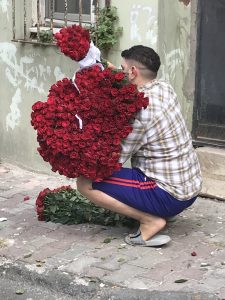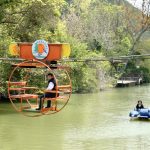‘Top of the Fields”
Market: Sunday
Gritty, rundown Tarlabaşı is a curiosity, a piece of prime real estate right in the heart of Beyoğlu, just minutes’ walk away from İstiklal Caddesi yet separated from it by busy Tarlabaşı Bulvarı and somehow allowed to fester largely disregarded. The history of the two areas is closely interwoven yet has led to two very different outcomes.
Backstory
İstiklal Caddesi was, as the Grand Rue de Pera, the street along which the 19th-century foreign embassies could be found and the buildings along it reflected their importance in an architecture which was grand, imposing and frequently highly decorative. The people who did the support work in the embassies and associated businesses could hardly be expected to afford such expensive accommodation so nearby in Tarlabaşı terraced houses on a more modest scale were built for them.
After the embassies were transferred to Ankara, the new capital, in the 1930s, Tarlabaşı, like İstiklal Caddesi, fell on hard times but, whereas İstiklal pulled itself out of the doldrums in the 1990s to become fashionable all over again, the empty houses of Tarlabaşı soon filled up with immigrants, mainly from the troubled southeast of the country, who didn’t actually own the properties they lived in.
From the middle of the 2000s property developers started to eye up the area, especially as Cihangir on the opposite side of İstiklal grew in popularity. In 2012 controversial gentrification work started along the edge of Tarlabaşı where it faced Tarlabaşı Bulvarı. As ever, it required that the poorer locals be evicted. In 2014 work stalled amid legal claims and counter-claims but the first tranche of buildings is now complete. Their design is not unpleasant but the location, with a busy main road out front and urban squalor to the rear, does not seem to have attracted many buyers.

As with SoHo in New York and Hoxton in London, some artists and media types moved in to be at the birth of the “new” Tarlabaşı but many of the old houses have been abandoned as construction work rips through the narrow streets. For the time being washing still hangs across child-filled streets which can feel pretty edgy after dark.
The best time to visit Tarlabaşı is probably when the colourful Sunday market is filling up Kurdele Sokağı and Serdar Ömer Paşa Sokağı. Go soon since experience elsewhere suggests that the market will eventually be moved into purpose-built undercover facilities.

Around Tarlabaşı
Tarlabaşı is separated from İstiklal Caddesi by busy Tarlabaşı Bulvarı which was forced through the area by mayor, Bedrettin Dalan, in the 1980s. It’s not an area with any major sights although there are a few oldish churches and one small museum to seek out. Chances are that all their doors will be locked.
Of the churches, the easiest to find is the sandstone Church of the Panagia (St Mary) in Karakurum Caddesi which is used by İstanbul’s small Syrian Orthodox community. Although there has been a church on the site since at least 1844 the current building only dates back to 1963.
Near the area that has been redeveloped is the huge Greek Orthodox Church of Sts Constantine and Helena (open Wednesdays) built in 1861.
 One house in Tarlabaşı was built on the site of the last home of Adam Mickiewicz (1798-1855), the Romantic poet who arrived in Istanbul in 1854 at the start of the Crimean War hoping to rally Polish forces to fight against Russia. He died during a cholera epidemic and a symbolic tomb lurks in the basement of the building. It now serves as the small but interesting Adam Mickiewicz Museum although his remains have since been returned to Cracow in Poland.
One house in Tarlabaşı was built on the site of the last home of Adam Mickiewicz (1798-1855), the Romantic poet who arrived in Istanbul in 1854 at the start of the Crimean War hoping to rally Polish forces to fight against Russia. He died during a cholera epidemic and a symbolic tomb lurks in the basement of the building. It now serves as the small but interesting Adam Mickiewicz Museum although his remains have since been returned to Cracow in Poland.
Sleeping
There are many small hotels and residences in Tarlabaşı, especially at the Talimhane end. Some are smart and stylish, others not so much. The problem is that the surrounding area remains rundown and rubbish-strewn.
For some visitors these places represent a chance to experience the “real” İstanbul; for others staying here might feel a little challenging.
Transport info
 Dolapdere is famous for its mannequins, Tarlabaşı for its wigs (peruk)
Dolapdere is famous for its mannequins, Tarlabaşı for its wigs (peruk)


